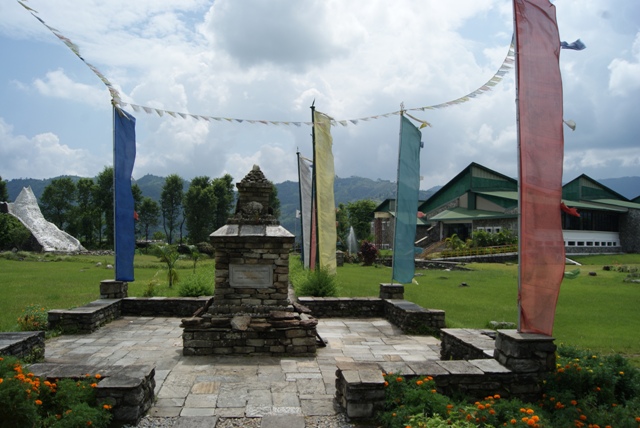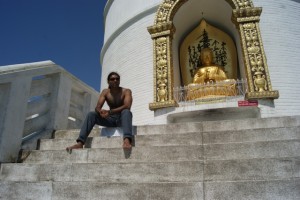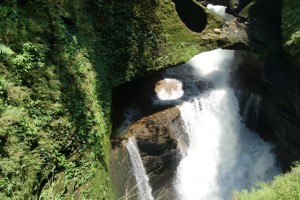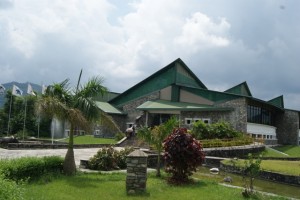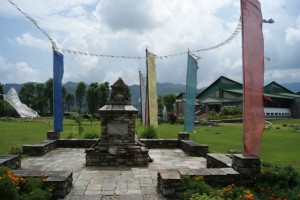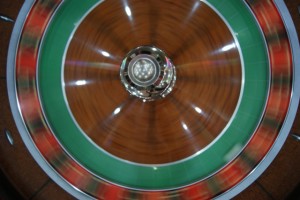At the Devi’s Falls too, locally known as Patale Chhango, there seemed to be no respite to the business aspirations of the locals. Only that with straw hats and cheap satchels, the shops here catered to a more touristy crowd than pilgrims. The gushing Devi’s Falls originates from the Fewa Lake. Though tourists are only a sprinkle, this is a popular picnic spot among the locals. Though no one could vouch for the veracity of the story behind the name, local folklore says that it was named after a tragic accident involving a Mrs Devi. Mrs Devi was a Swiss who travelled to Pokhara with her husband. They were bathing in the Fewa Lake when there was a flash flood. Here, some versions also say that she was swept away by the undercurrents of the lake. Attempts by her husband to save her were futile and her lifeless body was found near the waterfalls a few days later. Whatever be the genesis of the name, the Devi’s Falls is a picturesque visit. However, the area lacks basic facilities, doesn’t even have a decent eatery. After a quick lunch of wild bananas and biscuits, I left for the next on my checklist.
The International Mountain Museum, I was told, is the only one of its kind in the world. However, after the visit to the ‘prehistoric caves’, I was a bit sceptic about tall claims. Nevertheless, the museum did have some hidden gems in store. Set up as a tribute to all mountaineers who surrendered their lives to their brave endeavours, the mountain museum is a favourite with international tourists. The model of the Manaslu mountain by the museum entrance is evocative of the tribute. The Manaslu, unlike most of the Himalayan peaks, was first climbed by the Japanese, giving it a special place among Asian mountaineers. Not only was the first conquest Asian, but a large number of Japanese, Nepalese and South Korean lives have been lost in attempts to reach its summit. Manaslu, which means ‘soul’ in Sanskrit, also lays claim to the largest toll on lives by any peak in the region. On a spring day in 1972, it wiped off an entire expedition party of 15 in an avalanche.You don’t really have to be museum enthusiast to enjoy this museum – there is history, culture, all with a dash of adventure. The museum was established to document the developments in three areas: the origin of the major mountain systems of the world, the different people inhabiting the mountain regions and important feats in mountaineering. The museum has primarily four exhibit halls. They are the halls of, mountain people, world mountains, mountain activities and guest exhibitions. In the mountain section, there are photographs of the 14 peaks which are above 8,000 metres. Also called the eight thousanders. Most of the photographs are taken by expedition groups who set out for their summits. In the section of the mountain peoples, the exhibits give us a glimpse on the way of lives of different mountain folks – the utensils, weapons and other tools they used for everyday living. As I roamed around the museum it became apparent that people everywhere are the same – the only defining factor being the surroundings. The mountain people came across as a lot who deserved respect – for their fight against all odds to survive. So many years have passed and nothing much seemed to have changed from what I saw in the photographs to what was on ground. The priceless photographs and artefacts, fossils, dresses, weapons – all were illustrative of an era gone by. An era that has left behind a legacy we can call proudly our own. Everything had a place and there was a place for everything in this museum, evidently an outcome of serious passion. From highbrow to more frivolous pursuits, some quite expensive, I headed to the casino in the Pokhara Grande Hotel. Casinos are not exactly dime a dozen in Nepal. In fact, while there were only four in capital Kathmandu, in Pokhara there is only the Pokhara Grande. Being my last night in Pokhara, I decided to live it up a little bit. Hang out on the edge. It didn’t take long for me to wish that the Nepali government should have banned Indians too, along with the natives, from gambling.
The cool evening breeze had a sobering effect on me as I cruised along the lakeside Baidam, the wannabe-Thamel, trying to forget my ill-luck at the tables. It was here I came to know of the cultural programmes that inject new life to otherwise loss-infected miserable evenings. As the night wore on, I sat transfixed at the flowing movements of the gifted dancers. An irrepressible joy permeated the night from the graceful expressions, the lithe limbs and the innate sense of rhythm. Whatever the day held for me, I surely would be leaving the valley with a definite fondness for the land, the monuments and the people.


